A survey of user needs regarding the publication of archaeological reports identified a fieldwork publication as 'any work that serves to record and disseminate information derived from a fieldwork project (including watching briefs, evaluations, excavations, surveys of all kinds, and related artefact and ecofact analysis). Such publications range from monographs through papers in national, regional and local society journals, to summary reports in annual gazetteers. By definition, they are publicly available' (Jones et al. 2001). Archaeological grey literature is specifically defined as 'those reports that are not issued for public sale or widespread distribution' (Jones et al. 2001).
There is a professional and moral obligation upon an archaeologist to produce a report on the results of fieldwork (IFA 2001a-e). This is especially important for intrusive investigations as all excavation is destruction of primary evidence. As Planning Policy Guidance note 16 (PPG16) stresses, archaeological remains are a finite, non-renewable resource (DoE 1990). The concept of reporting, allied with the preparation of an ordered and stable archive, aims for 'preservation by record' to compensate for the loss of original evidence.
The following sections will focus on the growing trend of grey literature production in archaeology, particularly as a result of development-led fieldwork.
For more than a decade, there has been a dramatic increase in the production of archaeological reports. This can be related directly to the increase in the numbers of archaeological projects being carried out since the introduction in 1990 of PPG16 in England, Archaeology and Planning (DoE 1990; see Fig. 1). In 1994, this was followed by PPG15, Planning and the Historic Environment (DoE/DNH 1994). Prior to 1990, archaeological fieldwork was either rescue-led or research-driven. The majority of archaeological work currently undertaken in England is as a response to development and land-use changes, as a requirement of local and national planning policies that place emphasis upon preservation in situ or, as a second-best option, 'by record'. Detailed analysis of trends in archaeological investigations in England from 1990 to 1999 has been carried out by the Archaeological Investigations Project (AIP) at the University of Bournemouth (Darvill and Russell 2002). Approximately 28,000 archaeological investigations have been undertaken in this period, the majority of which remain unpublished (Darvill and Russell 2002, 6). Although the exact cost of this work is unknown, an approximate annual figure of between £60 and £80 million can be estimated.
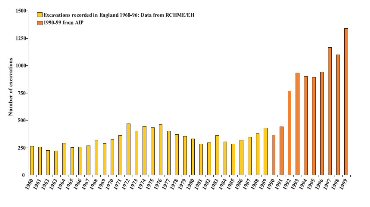
Figure 1: The number of excavations carried out in England by year for the period 1960-99 (Data from RCHME/English Heritage Excavation Index and AIP), after Darvill and Russell (2002, 53), illustration 35
Most archaeological projects are small in scale, such as watching briefs, desk-based assessments, geophysical surveys and trial trenching; the number of large-scale excavations, so often seen prior to PPG16, is low in comparison. Section 4.1.1 provides statistical information on projects undertaken within the North Yorkshire County Council area from 1999 to 2003; the AIP Project Webpage provides figures for national statistics 1990-2002 (see Fig. 2).
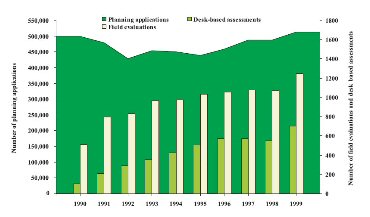
Figure 2: Trends in the number of desk-based assessments and field evaluations carried out in England 1990-99 in relation to the number of planning applications made. [Data from DoE/DETR and AIP], after Darvill and Russell (2002, 51), illustration 33
For those projects where significant results are obtained, there is usually a programme of post-excavation assessment, followed by further analysis and publication, where this can be justified, following the principles of MAP 2 (Andrews 1991). The issue of publication of archaeological reports, their content and structure has been one of long debate within the profession (see 1.8).
The majority of archaeological grey literature is commissioned by a developer on the advice of a 'curatorial' archaeologist, acting as archaeological advisor to a local planning authority, or by an organisation outside of the planning process that follows the principles of PPG16 or Environmental Impact Assessment procedures.
The underlying purpose of the majority of archaeological projects is to provide information in support of a planning application or other development proposal, or to mitigate the impact of development or other land-use change on the archaeology. In the greater number of cases, therefore, the commissioning body is a private developer, consultant or agent acting on their behalf (Darvill and Russell 2002, see Table 1). However, a wide range of other clients commission archaeological work for a variety of reasons, including private individuals, charitable organisations, local authorities and Government agencies. For many, this may be a one-off occasion; for others, a routine and regular occurrence. In some cases a specific archaeological organisation may be retained, in others, work may be put out to tender.
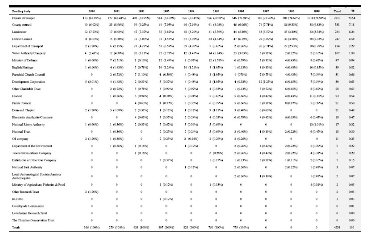
Table 1 Analysis of the funding sources for field evaluations 1990 to 1999, after Darvill and Russell (2002), table W14
The range of producers of archaeological grey literature is equally varied. As the quantity of archaeological projects has increased over the past decade, so too has the number of archaeological organisations. With the advent of competitive tendering in the 1990s, the monopoly of the traditional city or county-based units established in the 1970s was challenged by the emergence of commercial archaeological contractors, flourishing in the post-PPG16 era. Many of the larger environmental and engineering consultancies now employ teams of in-house archaeologists.
The AIP Project has analysed the geographic distribution of the main archaeological organisations working in England, and the relative quantity of projects they have undertaken (Darvill and Russell 2002, see Table 2 and Table 3). These figures show the top twenty organisations carrying out desk-based assessments and field evaluations. Section 4.1.1 provides statistical information for the situation in North Yorkshire between 1999 and 2003 (see Fig. 9).
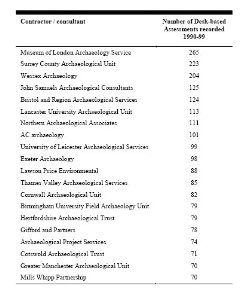
Table 2 Summary of the top twenty archaeological contractors carrying out desk-based assessments in England between 1990 and 1999, ordered in terms of the number of reports recorded by the AIP, after Darvill and Russell (2002), table W8
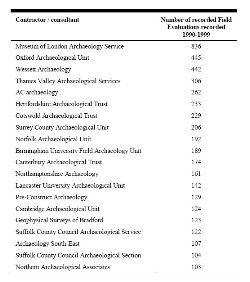
Table 3 Summary of the top twenty archaeological contractors carrying out field evaluations in England between 1990 and 1999, ordered in terms of the number of reports recorded by the AIP, after Darvill and Russell (2002), table W16
The range of archaeological contractors varies from small companies operating within a local area to larger organisations operating at regional and national level. A recent survey provides analysis of the current profile of the archaeological profession (Aitchison and Edwards 2003). Whilst some organisations have a limited number of employees, often hired on temporary contracts for particular projects, others have more permanent staff or use self-employed personnel. Some individuals and organisations specialise in particular projects, or techniques, such as Environmental Assessment or geophysical survey; others will undertake a range of projects. For larger infrastructure developments, such as pipeline and road schemes, there can often be a complex hierarchy of consulting and commissioning archaeologists, as well as sub-contracted and specialist organisations, all of whom will have their own styles of report production. Ultimately, therefore, authors may not have complete control over the final appearance of their reports once submitted to their client.
Although the organisations commissioning reports are predominantly commercial ones, there are a growing number of independent archaeologists, community and voluntary groups undertaking and commissioning archaeological work with the aid of Heritage Lottery or Local Heritage Initiative funding. University departments and metal-detecting clubs also undertake field projects and produce unpublished reports.
Unpublished archaeological reports are usually stand-alone documents; however, for some larger development schemes reports may be incorporated as a chapter or appendix within an Environmental Statement. Most organisations have developed their own house style in the presentation and format of their reports, using a particular layout or template, company branding and unique reference number.
It is ironic that the majority of report text is 'born digital'; it is usually word processed, using Microsoft Word, or Corel Word Perfect, yet these reports are, in the main, submitted in hard copy format and distributed by post. Occasionally, electronic versions of a report are submitted to an HER by e-mail, in Microsoft Word, or Adobe PDF format, usually for speed of transmission, and usually followed up by a hard copy report (see Section 2.7.1 for an outline of these formats). Reports are predominantly A4 format, often with illustrations on A3 paper, bound with a plastic comb, or coated metal spiral, binding. Depending upon the nature of the project results, these reports are typically between ten and sixty pages in length. Some negative watching briefs may only be a couple of pages long, or in the format of a letter. Three typical examples of unpublished reports have been chosen for the case-study presented in Section 4 (see 4.1.3).
The range of technical and computing skills within an organisation will vary, as will the availability and use of hard- and software (Condron et al. 1999, Table 8.1). Many now use Autodesk's AutoCAD as a means of producing digitised site plans and illustrations. The majority of field recording is still undertaken manually, although surveying and 3D small-finds recording is often carried out electronically, as is site photography. Where digital data are required, context records are usually entered by hand into a database during the post-excavation phase of a project. Archaeological organisations are increasingly using computers on site for larger excavation projects, but this is unusual for smaller-scale work. A review of training in professional archaeology by Chitty (1999, 17) identified skills in computer applications and use of digital data as the key priority for future training and development, specifically including use of the Internet and electronic media for public access. 'Professionals in archaeology commonly view themselves as poorly equipped to take advantage of using digital data or to develop the full opportunities offered by new computer applications in their work' (Chitty 1999, 21). Modest numbers of respondents (5%) identified public presentation and writing and publishing skills as areas for future professional development (see Figure 3).
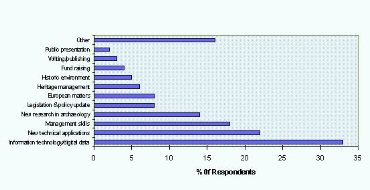
Figure 3: Identified future training needs in archaeology, after Chitty (1999), fig. 10
Professional standards decree that every archaeological project will be governed by specific aims and objectives, defined in either a written scheme of investigation, or a project design (IFA 2001a-e). A variety of factors will influence the content of a report, including the scope of work, the nature of results and the requirements of a particular client, curatorial archaeologist, and/or archive repository.
The IFA's Standard and Guidance documents provide an annexe of report section contents, which are broadly similar for all types of fieldwork or project (IFA 2001a-e). In the case of an excavation the particular requirements of a post-excavation assessment report are outlined, following the principles of MAP2 (Andrews 1991; IFA 2001d). These comprise: non-technical summary, introductory statements, aims and objectives, methodology, results, conclusions, archive location, appendices, illustrations, references and bibliography. There may also be recommendations for further work or mitigation measures arising from the project results. Fieldwork reports usually contain appendices of specialist reports covering palaeoenvironmental remains, ceramic assemblages, finds and dating techniques. They may also contain a copy of the specification or project design. For desk-based assessments, lists of sources consulted, and copies of relevant map extracts or other documents may be included, as well as detailed gazetteers of sites identified (IFA 2001a-e).
There are issues of quality control and peer review, as with any other literature. Editing and proof-reading are generally undertaken in-house, if at all. The IFA operates a system of registration for archaeological organisations that 'is an unreserved statement of quality and professionalism, an endorsement of integrity that is visible to potential sponsors and customers' (IFA 2004). The monitoring of the report and its content, however, is generally the responsibility of the curatorial archaeologist, who has to ensure that the requirements of the original specification and professional standards have been met. Many curators have inadequate resources, both in skills and time, to monitor these reports effectively, and quality control is therefore a significant issue.
A review of archaeological assessment procedures in England noted that circulation of client reports was poor, rendering archaeological information inaccessible and thus limiting opportunities for peer review. This survey also found that many reports lacked basic information that would make cataloguing and indexing easy and frequently lacked other useful information, such as source lists and a copy of the project design (Champion et al. 1995).
As discussed in 1.5.3, the majority of reports are 'born digital', yet printed in hard copy. These are distributed by post, and occasionally by hand (see Fig. 4). The results of most archaeological projects are disseminated only at the local level, including the relevant HER. A survey in 2002 revealed that 96% of HERs hold grey literature fieldwork reports (Newman 2002; see Fig. 5). The commissioning body and/or the organisation producing the reports generally controls their distribution, although the recipients and timescales for production are normally stated in the project design, as well as any publication proposals. This is, of course, dependent upon the significance of the project results. Most often this publication will be a note in a local journal. Distribution of single or multiple copies will usually include the client, the local planning authority, the local HER, English Heritage (if a Scheduled Ancient Monument is involved), the museum accepting the archive and the National Monuments Record.
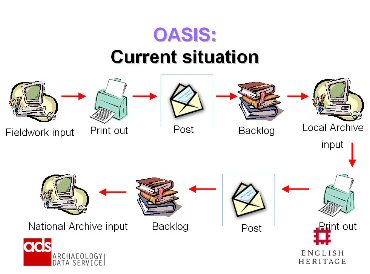
Figure 4: The current workflow of grey literature report distribution and heritage dataset record creation which the OASIS Project aims to improve, after Hardman (2004)
Reports are generally produced within six months of fieldwork, although if the client needs information sooner for commercial or planning reasons, interim reports may be produced more rapidly. The nature of the material recovered usually determines timescales, particularly if a specialist has been engaged to assess an assemblage or material sent away for dating. This can sometimes delay the appearance of a final report by months, if not years. Other factors, such as client confidentiality and site security, govern distribution of reports and are discussed in Section 2 (see 2.3.1).
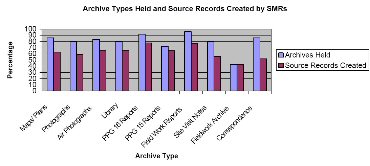
Figure 5: Archive types held and source records created by HERs, after Newman (2002), fig. 9
Once a report has been submitted to a curator, the results are fed back into the HER database and thus made publicly available. Figures 10 and 11 show examples of a typical event and source record within the HBSMR software used by the majority of HERs in England. Inevitably, there are often time delays in this process and for many areas of the country the HER database is available only by appointment, or through remote enquiry to the HER Officer. Increasingly, many HERs are being made available online and can be identified through the HEIRNET Register, accessible either via the ADS ArchSearch Catalogue, or independently through the HER's own website, for example that for County Durham and Northumberland through their Keys to the Past project. Generally, these online resources provide only a summary, or index-level, record of a particular project, and not access to full reports (see also 2.1.2).
Results may be communicated more widely through regional day schools and in local journals. Occasionally a developer will commission a leaflet for free distribution with a more popular audience in mind. These methods, however, apply to the minority of archaeological projects undertaken annually within England.
© Internet Archaeology
URL: http://intarch.ac.uk/journal/issue17/5/gf1-4to1-5-5.html
Last updated: Wed Apr 6 2005